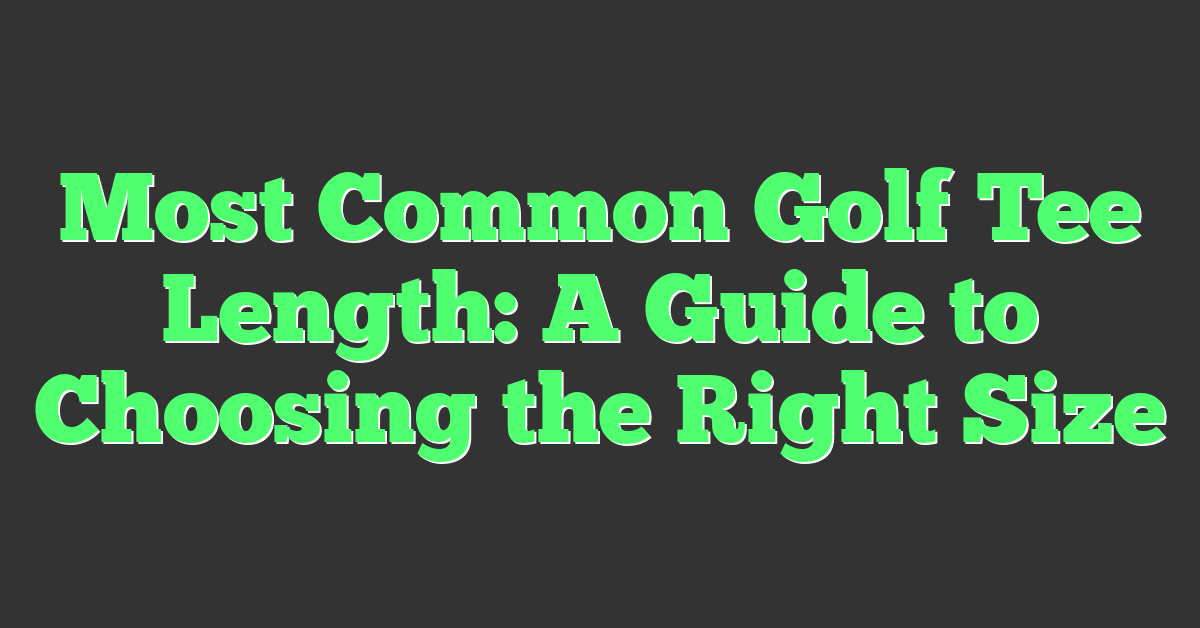If you’re a golfer, you know that the humble tee is an essential component of the game. But did you know that there are different lengths of golf tees available? The most common golf tee length is 2 3/4 inches, but shorter and longer options are also available. Understanding the role of tee length and how it affects your game can help you make better decisions when selecting tees for different holes.

The length of your golf tee can impact the height, distance, and accuracy of your shots. The longer the tee, the higher you can tee up the ball, which can help you achieve a higher launch angle and greater distance. However, longer tees may also increase the chances of slicing or hooking the ball. Shorter tees can help you achieve greater accuracy and control, but may limit your distance. Understanding the trade-offs between different tee lengths can help you choose the right tee for your game.
Key Takeaways
- The most common golf tee length is 2 3/4 inches, but shorter and longer options are also available.
- Tee length can impact the height, distance, and accuracy of your shots.
- Understanding the trade-offs between different tee lengths can help you choose the right tee for your game.
Understanding Golf Tee Lengths
When it comes to golf tees, the length of the tee can make a big difference in your game. The most common tee lengths are 2.75 inches and 3.25 inches, but there are other sizes available as well.
The 2.75-inch tee is typically used for irons, while the 3.25-inch tee is used for drivers and fairway woods. These standard tees have been used for many years and are still the most popular sizes on the market.
It is important to choose the right tee length for your specific club. Using a tee that is too long or too short can affect your swing and ball flight. A tee that is too short can cause you to hit the ball too low on the clubface, resulting in less distance and accuracy. On the other hand, a tee that is too long can cause you to hit the ball too high on the clubface, resulting in less distance and accuracy as well.
When selecting a tee size, consider the size of your clubhead. Larger clubheads may require a longer tee to get the ball up in the air, while smaller clubheads may require a shorter tee. It is also important to consider the type of shot you want to hit. If you want to hit a higher shot, a longer tee may be necessary.
In addition to standard tees, there are also adjustable tees available that allow you to change the length of the tee based on your needs. These tees can be a good option if you want to experiment with different tee heights or if you have multiple clubs with different clubhead sizes.
Overall, understanding golf tee lengths is an important part of improving your game. By selecting the right tee length for your club and shot, you can improve your distance and accuracy off the tee.
The Role of the Driver
https://www.youtube.com/watch?v=VwUWRR-9PRo&embed=true
If you’re looking to improve your golf game, optimizing your driver tee height is a great place to start. The driver is the most important club in your bag, and getting the right tee height can make a big difference in your ball flight, distance, and overall performance. In this section, we’ll explore how to optimize your driver tee height and choose the right tees for your driver.
Optimizing Driver Tee Height
According to Golf.com, the optimal tee height for your driver is to have the middle of the ball at the top edge of the driver face. This allows for the most efficient transfer of energy from the club to the ball, resulting in maximum distance and accuracy. However, tee height can vary depending on your swing speed, angle of attack, and the type of driver you’re using.
To find the right tee height for your driver, try experimenting with different heights during practice rounds. Start with the middle of the ball at the top edge of the driver face and adjust from there. Pay attention to your ball flight and distance, and make note of the tee height that produces the best results.
Choosing Tees for Drivers
When it comes to choosing tees for your driver, there are a few things to consider. First, make sure the tee is long enough to accommodate the size of your driver head. Use longer tees with big clubs like drivers and shorter ones with irons and hybrids, as recommended by Golfusers.com. The material of the tee is also essential; plastic tees last longer and are more durable than wooden ones.
Second, consider the tee’s height. As we mentioned earlier, the optimal tee height for your driver can vary depending on your swing speed and angle of attack. If you’re not sure what tee height to use, start with the middle of the ball at the top edge of the driver face and adjust from there.
In conclusion, optimizing your driver tee height and choosing the right tees for your driver can make a big difference in your golf game. Experiment with different tee heights during practice rounds and pay attention to your ball flight and distance to find the right tee height for your swing. And when choosing tees for your driver, make sure they’re long enough to accommodate the size of your driver head and consider the tee’s height to optimize your performance.
Tee Height and Golf Ball Performance
https://www.youtube.com/watch?v=jMpOHfyKVbQ&embed=true
When it comes to golf, every shot counts. The tee height you use can have a significant impact on your golf ball’s performance. In this section, we’ll explore the relationship between tee height and golf ball performance.
Impact on Distance and Trajectory
The height of the tee affects the angle of attack on the ball, which in turn affects the distance and trajectory of the ball. Using a higher tee height can help you get more distance on your shots, especially with your driver. When the ball is teed up higher, it allows you to hit the ball on the upswing, resulting in a higher launch angle and more carry distance.
On the other hand, using a lower tee height can help you hit a more controlled shot with less spin. This can be particularly useful when hitting with irons or fairway woods. A lower tee height can help you hit the ball with a more descending angle of attack, which can lead to a lower launch angle and less spin.
Ball Flight and Accuracy
The height of the tee can also affect the ball flight and accuracy of your shots. A higher tee height can lead to a higher ball flight, which can be beneficial when you need to clear an obstacle like a tree or bunker. However, a higher tee height can also lead to more side spin, which can result in a less accurate shot.

« Where Are Good Golf Balls From? A Guide to Finding Quality Golf Balls
Which Golf Balls are the Best? A Friendly Guide to Choosing the Right Ones »
Conversely, a lower tee height can lead to a lower ball flight, which can be beneficial when you need to keep the ball under the wind or hit a shot with more accuracy. A lower tee height can also help reduce side spin, resulting in a more accurate shot.
In conclusion, the height of the tee can have a significant impact on your golf ball’s performance. When choosing a tee height, it’s important to consider the club you’re using, the shot you need to hit, and your personal preferences. Experiment with different tee heights to find the one that works best for you and your game.
Selecting Tees for Irons and Fairway Woods
https://www.youtube.com/watch?v=MgYVhGRpTN4&embed=true
When it comes to selecting the right tee for your iron shots and fairway woods, there are a few things to consider. The height of the tee can have a significant impact on your swing and the flight of the ball.
Iron Tee Height
For iron shots, you want to use a tee that is shorter than what you would use for your driver. The standard tee height for irons is around 1 inch to 1.5 inches. This height allows you to hit down on the ball and make solid contact with the clubhead. It also helps to create a divot after the shot, which is a good sign of a proper swing.

Using a tee that is too high can cause you to hit the ball too high on the clubface, resulting in a loss of distance and accuracy. On the other hand, using a tee that is too low can cause you to hit the ground before making contact with the ball, resulting in a poor shot.
Fairway Wood Tee Height
For fairway woods, you want to use a tee that is slightly taller than what you would use for your irons. The standard tee height for fairway woods is around 1.5 inches to 2 inches. This height allows you to hit up on the ball and get the ball airborne quickly.
Using a tee that is too low can cause you to hit the ground before making contact with the ball, resulting in a poor shot. On the other hand, using a tee that is too high can cause you to hit the ball too high on the clubface, resulting in a loss of distance and accuracy.
Overall, selecting the right tee height for your iron shots and fairway woods can have a significant impact on your swing and the flight of the ball. By using the standard tee heights mentioned above, you can ensure that you are making solid contact with the clubhead and getting the ball airborne quickly.
Material and Design of Golf Tees
When it comes to golf tees, there are two main types: wooden and plastic. Wooden tees are the traditional choice, and they are still very popular today. They are typically made from hardwood, such as birch or maple, and they come in a variety of lengths and colors. Plastic tees, on the other hand, are a more recent invention. They are made from materials like polypropylene and are available in a wide range of lengths and colors.

Wooden vs Plastic Tees
Wooden tees have been around for a long time, and they are still a popular choice among golfers. They are inexpensive, easy to find, and biodegradable. They come in a variety of lengths, so you can find the perfect size for your swing. However, wooden tees can break easily, especially if you use a driver with a large head. They can also be difficult to insert into hard ground.
Plastic tees, on the other hand, are more durable than wooden tees. They can withstand repeated use and are less likely to break. They are also available in a wide range of lengths, so you can find the perfect size for your swing. However, plastic tees can be more expensive than wooden tees, and they are not biodegradable.
Specialized Tee Designs
In addition to wooden and plastic tees, there are also specialized tee designs available. Bamboo tees, for example, are a more eco-friendly option than traditional wooden tees. They are made from sustainable bamboo and are biodegradable. Brush tees are another specialized design. They have bristles instead of a traditional tee top, which can help reduce friction and increase distance. Zero friction tees are another option. They are designed to reduce friction between the tee and the ball, which can help increase distance and accuracy.
Overall, the material and design of your golf tee is a matter of personal preference. Wooden tees are a classic choice, while plastic tees are more durable. Specialized tee designs offer unique benefits, such as reduced friction or increased eco-friendliness. Consider trying out different types of tees to find the one that works best for you and your swing.
Personal Preference and Tee Selection
Choosing the right tee length is crucial for optimal performance. The most common length of a golf tee is about 2 3/4 inches, but the size you choose depends on your personal preference and the type of club you are using.
When selecting a tee, consider your playing style and swing style. If you have a fast swing speed, you may want to use a longer tee to elevate the ball higher off the ground. Conversely, if you have a slower swing speed, a shorter tee may be more appropriate.
It’s also important to consider the type of club you are using. If you are teeing off with a driver, you may want to use a longer tee to elevate the ball higher off the ground. If you are using a fairway wood, hybrid club, or iron, you will want to use a smaller tee.
If you are unsure about which tee length to use, consider seeking advice from a golf pro. They can help you determine the best tee length based on your swing style and playing style.
Confidence also plays a role in tee selection. If you feel more confident using a certain length tee, then use it. Golf is a mental game, and feeling confident in your equipment can help improve your performance.
Overall, tee selection is a personal preference based on a variety of factors. Experiment with different tee lengths to find the one that works best for you.

Skill Level and Tee Choice
https://www.youtube.com/watch?v=T8yRFqqTxFQ&embed=true
When it comes to golf, choosing the right tee length is crucial for ensuring a good game. The length of the tee can affect your shot distance, trajectory, and overall performance. Therefore, it is important to choose the right tee length based on your skill level.
Beginners and Tee Length
If you are a beginner, it is recommended that you start with a longer tee length, such as 2 3/4 inches. This length allows you to hit the ball higher and farther, which can be beneficial for beginners who are still working on their swing and club selection. Additionally, longer tees are easier to use, as they provide more room for error.
Advanced Players and Tee Strategy
As you progress in your golf skills, you may want to experiment with different tee lengths to improve your game. For example, some advanced players prefer shorter tees for their irons, as this can help them achieve a lower ball flight and more spin. Additionally, shorter tees can be helpful when playing on windy days, as they provide less resistance to the wind.
When choosing a tee length, it is also important to consider your club selection. For example, if you are using a driver with a larger clubhead, you may want to use a longer tee to ensure that the ball is teed up at the correct height. Similarly, if you are using a fairway wood or hybrid, you may want to use a shorter tee to achieve a lower ball flight.

Overall, choosing the right tee length is an important part of your golf equipment and club selection. By considering your skill level and club selection, you can choose a tee length that will help you achieve the best possible shot.
Environmental Factors Affecting Tee Usage
When it comes to golf tees, there are a number of environmental factors that can affect their usage. These factors include grass length, course conditions, elevation, and course layout. In this section, we will explore these factors in more detail and how they can affect your tee choice.
Grass Length and Tee Height
One of the most important factors to consider when choosing a tee is the length of the grass on the tee box. If the grass is long, you may need to use a longer tee to get the ball high enough off the ground. On the other hand, if the grass is short, you may be able to use a shorter tee.
It’s important to note that the height of your tee can also affect the trajectory of your shot. A higher tee can help you get more height on your shot, while a lower tee can help you keep the ball low.
Course Conditions and Tee Choice
Another factor that can affect your tee choice is the condition of the course. If the course is wet or muddy, you may want to use a longer tee to keep the ball from getting stuck in the ground. On the other hand, if the course is dry and hard, you may be able to use a shorter tee.

Additionally, the layout of the course can also affect your tee choice. If the course has a lot of elevation changes, you may need to use a longer tee to get the ball high enough to clear obstacles. Conversely, if the course is relatively flat, you may be able to use a shorter tee.
Overall, when choosing a tee, it’s important to consider a variety of environmental factors, including grass length, course conditions, elevation, and course layout. By taking these factors into account, you can choose the right tee for your shot and improve your chances of success on the course.
Golf Clubs and Tee Compatibility
https://www.youtube.com/watch?v=tAaCWXJBk20&embed=true
When it comes to selecting the right tee length, it is important to consider the type of golf club you are using. The length of the tee can affect the trajectory and distance of your shot, so it is important to choose the right length for your club.
For drivers, it is recommended to use tees that are 3.25 to 4 inches in length. This allows you to tee the ball high enough to get a good launch angle and maximize distance. On the other hand, for irons and hybrid clubs, shorter tees that are 1.5 to 2.5 inches in length are recommended. This will allow you to hit the ball cleanly and accurately.
When choosing a tee length, it is also important to consider the type of club head you are using. For example, if you are using a wedge, you may want to use a shorter tee to help control the height and spin of your shot. Additionally, if you are using a club with a larger club head, such as a driver, you may want to use a longer tee to help ensure that you are teeing the ball high enough.
Ultimately, the choice of tee length will come down to personal preference and club choice. It is important to experiment with different tee lengths to find the one that works best for your swing and playing style. By selecting the right tee length, you can improve your accuracy, distance, and overall performance on the course.
Practical Tips for Consistent Tee Usage
When it comes to golf tees, consistency is key. Here are some practical tips to help you use your tees effectively and consistently.
Mastering Tee Height for Consistency
The height of your tee can have a significant impact on your performance. For drivers, you’ll want to use a longer tee to help you get the ball in the air and maximize your distance. For irons, a shorter tee will help you hit the ball cleanly and accurately.
To ensure consistent tee height, consider using adjustable tees like the Telos Tee. These tees allow you to easily adjust the height based on the club you’re using, so you can be sure you’re getting the most out of your shots.

Maintaining Balance and Precision
In addition to tee height, it’s important to maintain balance and precision when using your tees. Make sure your ball is centered on the tee and that the tee is firmly planted in the ground. This will help you strike the ball cleanly and avoid mishits.
You can also use alignment aids like color-coded tees to help you maintain consistency and accuracy. These tees come in different colors based on the height, so you can quickly and easily find the right tee for the club you’re using.
By following these practical tips, you can improve your tee usage and overall performance on the course. Remember to stay consistent and focused, and you’ll be well on your way to success.
Choosing the Right Golf Tee for Different Holes
When it comes to golf tees, size matters. The right size of tee can help you achieve the perfect shot, while the wrong size can lead to frustration and missed opportunities. Here are some tips for choosing the right golf tee for different holes.
Tee Strategy for Par-3 and Par-4
For par-3 and par-4 holes, you’ll want to use a shorter tee. A tee that’s around 2 1/8 inches is perfect for these holes. This tee height will allow you to get the ball off the ground quickly and achieve the desired trajectory. With a shorter tee, you’ll also have more control over the ball, which is essential for shorter holes where accuracy is key.

Adapting Tee Size for Course Layout
When it comes to par-5 holes, you’ll want to use a longer tee. A tee that’s around 3 1/4 inches is perfect for these holes. This tee height will allow you to get the ball higher off the ground, which is essential for longer shots. With a longer tee, you’ll also have more room for error, which is important on longer holes where accuracy is less of a factor.
It’s also important to adapt your tee size based on the layout of the course. If the course has a lot of doglegs or other obstacles, you may want to use a portable tee that can be adjusted to different heights. This will allow you to adapt to the course as you play, giving you the best chance for success.
When choosing a golf tee, it’s important to consider the manufacturer. Some manufacturers produce tees that are more durable and long-lasting than others. Look for tees that are made from high-quality materials and are designed to withstand the rigors of regular use.
In summary, choosing the right golf tee for different holes is essential for achieving success on the course. By using the right tee size and adapting to the course layout, you can improve your accuracy and achieve the perfect shot every time.
Frequently Asked Questions
What are the benefits of using different golf tee lengths?
Using different tee lengths can help you achieve different ball heights and angles, which can affect your shot trajectory and distance. Longer tees are generally used for drivers and fairway woods, while shorter tees are recommended for irons and hybrids. Experimenting with different tee lengths can help you find the right balance of height and distance for your swing.

How does tee length affect driving distance and accuracy?
Tee length can affect both driving distance and accuracy. A longer tee can help you achieve a higher ball flight and longer distance, but it can also increase the likelihood of slicing the ball. On the other hand, a shorter tee can help you hit the ball lower and straighter, but it may sacrifice some distance. Finding the optimal tee height for your swing can help you strike a balance between distance and accuracy.
What are the pros and cons of plastic versus wooden golf tees?
Plastic tees are generally more durable and can be reused multiple times, while wooden tees can break more easily and need to be replaced more frequently. However, wooden tees are biodegradable and environmentally friendly, while plastic tees can contribute to pollution if not disposed of properly. Ultimately, the choice between plastic and wooden tees comes down to personal preference and environmental considerations.
Is there a standard size golf tee for professional players on the PGA Tour?
There is no official standard size for golf tees on the PGA Tour, but most players use tees that are around 2 3/4 inches in length. Some players may prefer longer or shorter tees depending on their swing and the conditions of the course.
What tee size is recommended for hitting irons?
For hitting irons, a shorter tee is generally recommended, with an ideal length of 2.75 inches or less. This can help you hit the ball lower and straighter, which is important for achieving accuracy with shorter clubs.
How can I determine the best tee height for my personal golf swing?
The best tee height for your swing will depend on a variety of factors, including your club selection, swing speed, and personal preferences. Experimenting with different tee heights during practice rounds can help you find the tee height that works best for your swing. As a general rule of thumb, the halfway point of the ball should be in line with the top of your driver for optimal distance and trajectory.










